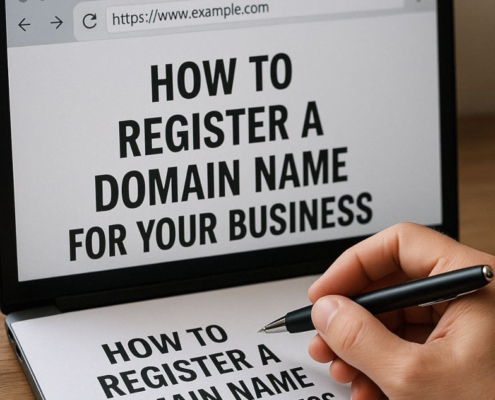Introduction
One approachable route to entrepreneurship is launching a dropshipping company. When a consumer places an order on your dropshipping website, the supplier sends the item straight to your customer, saving you money on overhead and the necessity to keep inventory on hand.
To start a dropshipping business, adhere to the following nine guidelines.
How to launch a dropshipping business
- Assess whether dropshipping is a viable business strategy for you.
- Select a niche of dropshipping.
- Investigate competitors
- Select a supplier.
- Choose your items and establish your prices.
- Establish an online store
- Select a structure for your company.
- Establish finance
- Promote your dropshipping business
1. Assess whether dropshipping is a viable business strategy for you.
One strategy for managing a web-based business is dropshipping. Make sure the company model is appropriate for your objectives before committing.
Individuals with marketing expertise who wish to operate a store with little initial capital are usually good candidates for dropshipping. You can get started with a computer and a connection to the internet because you don’t have to touch or stock things.
However, there are compromises associated with this level of accessibility. Because other merchants are likely to offer the same products, drop shippers face severe competition and typically have a smaller say over what is included in their catalog.
Dropshipping might be useful for you if you want to concentrate on marketing rather than establishing your company around a signature item.
2. Select a niche of dropshipping
A market niche is a subset of the market. You can use your brand, store, and product choices to target a specific niche.
Finding a target market is aided by choosing a dropshipping specialty. It’s simpler to look for things to dropship when you have a certain buyer in mind.
Choosing a business niche can be done in two broad ways:
- Select a niche in which you have expertise or an interest.
- Based on the needs of the market, select a niche.
The second strategy looks for market niches where there is little competition but a lot of consumer interest. Through product and keyword research, drop shippers determine the demand in the market.
Using keyword research to identify a niche
Researching keywords reveals what people are looking for online. Product-related queries that are popular and that your e-commerce site might be able to offer are revealed by tools like Facebook Audience Insights, Google Trends, & Keywords Everywhere.
Consider historical interest in addition to search volume when evaluating search demand to identify a niche that is becoming more and more popular over time.
John Murphy, the creator of eBike Generation, was able to uncover an underserved niche—e-bikes for hunters—by using keyword research to launch a three-million-dollar dropshipping business.
Researching products to find a niche
Finding popular products and understanding consumer preferences across various product categories are made easier with the use of product research.
You may estimate the possible scale of your business by using dropshipping tools like DSers to view product quantity orders on marketplaces like AliExpress.
To create a complete image of a dropshipping niche, combine the two methods of research. Rapid changes in consumer behavior mean that you should regularly monitor product popularity and keyword trends.
You may also choose to pick your dropshipping supplier before deciding on a specialization in order to match your business alongside product availability.
3. Investigate competitors
When launching a dropshipping business, a competitor study is helpful. Take your time obtaining information about competitors’ stores in your market.
Potential items and marketing techniques might be identified by keeping an eye on what your rivals—especially similar drop shippers—are offering. Examine product pages & social media advertisements to determine what draws in buyers.
Use these tasks to conduct in-depth competition research:
- Perform a Google search.
- Employ tools for competitive analysis
- Examine social media
- Analyze markets
Perform a Google search.
To find out which companies show up, start by Googling for terms associated with your niche. One way to find potential customers for your dropshipping business in the pet-related category would be to look for terms like “pet toys,” “pet brushes,” or “pet foods.”
See which companies frequently appear in your search results by paying close attention to them. For audiences found through organic searches, these are probably your top rivals. Use an SEO tool to get more detailed insights.
It’s possible that competitors with higher rankings tailor their content to attract clients using keywords with long tails which are more specialized and lengthier phrases.
Smaller dropshipping sites should strategically go for long-tail keywords because they face less competition.
For instance, your competitor research may show that big stores are fighting for the phrase “dog collars,” but there is lower competition for “LED dog collars” and space for your new company in “LED dog collars for little dogs.”
Employ tools for competitive analysis
Another method for learning about competitors’ strategies is to use competitor analysis tools. Track sources of traffic, visitor numbers, and social media activity for additional data.
One way to counter a competitor’s heavy reliance on paid advertising could be to launch a rival campaign or increase your investment in search engine optimization material. Establishing a channel could be advantageous if they are involved on a social media site that you haven’t seen.
Examine social media
Observe how rivals interact with their followers on social media by following their pages. Keep an eye on the kinds of postings that receive the most shares, likes, and comments.
For instance, you can think about making content akin to the DIY grooming videos that a rival in the pet supplies industry is making popular. Additionally, keep an eye out for any gaps—it’s possible that there is an unmet demand for pet wellness content.
Analyze markets
Expert advice can also be obtained from sellers in your specialty on e-commerce sites like Etsy, Amazon, and eBay.
Take note of the quantity of listings for comparable goods. If the industry seems saturated, think about how you may set yourself apart with your product listings—for example, by lowering your prices or providing a superior client experience that can’t be obtained through an online marketplace.
Maintain a spreadsheet with all of your competitor analysis so that you can easily search and use the results.
4. Select a supplier
A dropshipping provider arranges shipment to customer addresses, sources and maintains inventory, and takes payments and orders.
Your dropshipping business’s performance will be greatly impacted by the supplier you choose because of these fundamental duties.
You might collaborate with one vendor or use a supplier list to engage with several vendors, depending on your industry and the goods you sell.
Well-known websites and apps for supplier directories instantly link your store to an extensive ecosystem of dropshipping vendors.
5. Choose your products and establish your prices
Your vendor’s inventory determines what products you can sell in your business. It’s crucial to choose products that appeal to your target market because you’ll find a lot of identical items in competing dropshipping businesses.
Upselling and cross-selling occur when customers add more or more expensive goods to their carts for purchase as a result of a carefully curated product catalog.
Examine other vendors’ feedback and the supplier’s track record of performance when choosing products from an application or marketplace. Order product samples after your shortlist is complete in order to evaluate consistency and quality.
Selecting goods that qualify for accelerated mailing services like ePacket shipment from China is something to think about if your plan calls for working with foreign suppliers. Delivery times may be greatly shortened as a result.
Setting a price for your dropshipping goods
You’ll need a price plan to make your dropshipping company profitable and sustainable, regardless of the products you sell—be it toys, apparel, or electronics.
Determine the margin of profit for each product, regardless of price, by adding up all of your costs, such as supplier fees and other running costs. To make sure that your shop is competitive, weigh this against the cost of comparable products on the market.
6. Establish an online store
With a checkout process and a display of your product inventory, your online store serves as the center of your dropshipping enterprise. Traffic from social media advertisements also goes there.
Your shop can offer material to improve the user experience outside of product pages. Buying guidelines, user manuals, product reviews, and pertinent blog entries fall under this category. Not only does extra content facilitate customer decision-making, but it also raises a store’s ranking in search results.
7. Select a structure for your company
The legal creation of a corporation and writing the business plan are the preliminary processes of the long-term development of a dropshipping business model.
A dropshipping business may use one of three typical business structures:
- Sole proprietorship
- LLC
- C Corp
Sole proprietorship
All that is needed is one worker and no additional tax returns or documents are required for a sole proprietorship. Thus, it ranks as one of the most preferred company models for drop shippers who want to keep things relatively uncomplicated and inexpensive.
Solitary proprietorships, however, do not provide asset protection for the owner in the event that the company has legal issues.
LLC (Limited Liability Company)
Establishing a dropshipping firm as an LLC (Limited Liability Company) allows you to keep your personal assets and business finances apart, which is more secure and simplifies accounting.
LLCs provide customizable tax benefits over single proprietorships, which could result in financial savings. However, you’ll have to pay incorporation charges and adhere to extra filing procedures.
C Corporation
C companies provide broad liability protection, which is why many major organizations choose to structure themselves as such. Since income doesn’t go directly to the stockholders, C companies can be costly to form and may be susceptible to double taxation.
You should speak with a lawyer to determine which business structure is ideal for your circumstances before selecting one.
8. Establish finance
Separating your personal and corporate finances simplifies bookkeeping and preserves the financial transparency of your organization.
Take a look at these fundamental financial obligations:
Open a bank account for your business.
In order to deposit revenue, open a company bank account. Tracking revenue and expenses is made simpler and financial accountability is guaranteed with a separate account for the dropshipping store.
Request a credit card for your business.
Ordering products, paying for software subscriptions, paying for advertising, and other costs could benefit from using a company credit card. As an added bonus, if you select a card that has benefits, you may receive rewards for keeping your personal and work costs apart.
Check the requirements for local business licenses.
In your city, a business license may be needed even if you work from home. You must confirm that you are in compliance with all local laws by verifying with the local government, as requirements may differ.
Gather sales tax.
If the state where your firm is located mandates sales tax collection, then do so. Sales tax is typically not required for orders placed outside of your state, but it’s a good idea to keep up with the most recent regulations.
Be ready to gather sales taxes from qualified clients if your state imposes a sales tax.
9. Promote your dropshipping company
After you launch your dropshipping store, focus on marketing. The best chance for success for your dropshipping business is an active marketing campaign that drives customers to your store.
Create a plan of action for these marketing platforms:
Paid advertising
Play around with the advertisements on Google, YouTube, TikTok, Instagram, and Facebook. Google AdWords targets customers with precise purchase intentions, but social media advertising helps build your brand’s reputation among relevant audiences.
You can find the most efficient strategy by testing advertising on both platforms.
Influencer marketing
You can boost your reach & credibility by working with influencers on social media sites like Instagram and TikTok. This could result in more purchases.
Content marketing
You may increase the visibility of your business by creating a content marketing strategy. Think about creating educational films, podcasts, or blogs in relation to what you specialize in. Customers who are engaged with your content after they make a purchase.
Communities
Engage in conversations with people who share your enthusiasm for your niche. Establishing trustworthy connections can be achieved by taking part in discussions on websites like Reddit & Facebook Groups, provided that you don’t become unduly focused on making sales.
Mobile Marketing
SMS marketing tactics typically yield a great deal of engagement, provided that you can compile a list of subscribers. A VIP discussion group, live chat assistance, or messages with temporary promo codes are some ideas to consider.
Email marketing
After a customer leaves your website, email marketing helps keep the relationship going. Recurring business can be encouraged by sending tailored emails that contain specials and helpful information.
Avoid these dropshipping errors
Operating a dropshipping store has its hurdles, just like any other retail venture. To maintain your business expansion, steer clear of these typical dropshipping pitfalls:
1. Disregarding sales data
Not paying careful attention to the trends their data on sales is showing them is a common mistake made by novice drop shippers.
Keep an eye on sales, and don’t be reluctant to make store changes to maximize revenue. Frequently verify:
- Which products are sold poorly and which are selling successfully?
- What your advertising revenue is?
- Which goods are bringing in the most money for you?
- The way that sales patterns are evolving over time.
- The devices and places from which your clients are coming.
2. Ignoring SEO
Your online presence is important because it immediately affects traffic and sales, regardless of how your clients find you—through social media or Google.
Consequently, neglecting the search engine optimization of your website may hinder your development. Be careful to concentrate on:
- Producing unique and informative text for product sites.
- Enhancing the loading speed of your website.
- Facilitating mobile device use for your website.
To assess the performance of your website and identify areas for growth, utilize Google Search Console.
3. Not preparing for expansion
If you’re not ready to expand, your company may become stuck. Create your store with the order volume of next year in mind, not the one from today. Avoid restrictions like these:
- Depending just on one vendor. To reduce risks and maintain product inventory, always search for alternatives.
- Taking orders by hand. Make use of an automated dropshipping program to process orders.
Accepting ever higher order quantities without requiring a substantial financial commitment is one advantage of dropshipping. Set up your processes so you are capable of handling more orders as they come in.
4. Ignoring dissatisfied clients
Although drop shippers don’t handle inventory directly, they serve as the main point of contact for customer service. Negative feedback and a high proportion of repeat business might result from failing to pay attention to clients, particularly those who have complaints.
In order to improve the clientele you serve:
- Write precise descriptions of your products.
- Give your contact information in a straightforward and understandable manner.
- Address all inquiries and grievances from clients.
- Prior to contacting the supplier, expeditiously handle returns and refunds.
You can respond to customers right away with the help of the newest chatbots and artificial intelligence (AI) products.
FAQs: How to Begin Dropshipping
- How should a dropshipping company be started?
-
- Choose a niche: Choose a niche market to pursue.
- Investigate rivals: Examine the companies in your niche that are flourishing and understand why.
- Select a supplier for dropshipping: Collaborate with a dependable vendor who has the goods you wish to offer in stock.
- Make an internet-based store: Create and develop an e-commerce website to display your goods.
- Promote your enterprise: To draw in customers, use compelling content and social media marketing.
- What is the best way to locate items for dropshipping?
Selecting a market with strong demand but little competition can help you choose which products are ideal for your dropshipping company. Using resources such as Google Trends, find consumer preferences and trends. Then, use market data analysis to identify goods that will be successful.
- Does dropshipping actually make money?
Because merchants do not have to worry about production or delivery, dropshipping may prove a lucrative venture. Over $100,000 is a common annual income for drop shippers. However, drop shippers face intense competition due to the ease of beginning a business, which limits their possible profit margins.






























